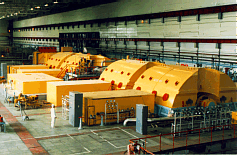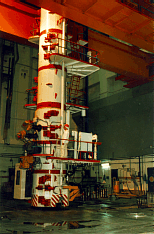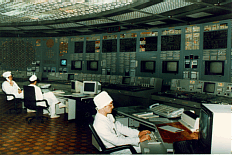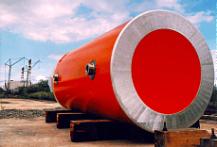|
 The
main structural element of the reactor, a graphite stack with fuel channels,
absorberrods and surrounding metal structures, is housed in a concrete vault.
The vertical graphite stack columns contain fuel channels and control rod
channels. The graphite stack is carried by a welded steel structure resting on a
concrete foundation. On top the graphite stack is spanned over by an upper steel
structure resting on the annular water tank of the biological shield. A welded
shell enclosing the graphite stack, as well as the upper and bottom steel
structures form a sealed reactor space. To prevent graphite oxidation and to
improve heat transfer from graphite to fuel channels, the reactor space is
filled with a helium-nitrogen mixture. The
main structural element of the reactor, a graphite stack with fuel channels,
absorberrods and surrounding metal structures, is housed in a concrete vault.
The vertical graphite stack columns contain fuel channels and control rod
channels. The graphite stack is carried by a welded steel structure resting on a
concrete foundation. On top the graphite stack is spanned over by an upper steel
structure resting on the annular water tank of the biological shield. A welded
shell enclosing the graphite stack, as well as the upper and bottom steel
structures form a sealed reactor space. To prevent graphite oxidation and to
improve heat transfer from graphite to fuel channels, the reactor space is
filled with a helium-nitrogen mixture.
Provision
is made to replace the fuel channels and control rod channels on the shut-down
and cooled reactor.
The
fuel channels are tubes whose lower and upper portions are fabricated from
corrosion-resistant steel, while the central part is made of Zircalloy. The
split graphite rings in the channels provide thermal contact with the graphite
bricks of the stack.
Suspended
in the fuel channel is a fuel assembly bank.
The
fuel assembly bank consists of two fuel assemblies. Each fuel assembly contains
18 fuel rods in the form of sealed Zircalloy tubes which are filled with uranium
dioxide pellets.
Light
water coolant is fed into the lower end of the fuel channels. From the fuel
channel the coolant in the separators. To improve heat exchange, the upper fuel
assembly carries special intensifying grids.
Removal
of irradiated fuel elements, their handling and charge of fresh elements are
performed on load by means of a refueling machine mounted in the central room.
The
biological shield is made of carbon steel, serpentine crushed stone and gravel,
concrete, sand, water.
|
 The
Ignalina nuclear power plant contains RBMK-1500 water-cooled graphite-moderated
channel-type power reactors. The RBMK-1500 reactor is the largest power reactor
in the world. The thermal power output of one units is 4800 MW, the electrical
power capacity is 1500 MW.
The
Ignalina nuclear power plant contains RBMK-1500 water-cooled graphite-moderated
channel-type power reactors. The RBMK-1500 reactor is the largest power reactor
in the world. The thermal power output of one units is 4800 MW, the electrical
power capacity is 1500 MW. 



